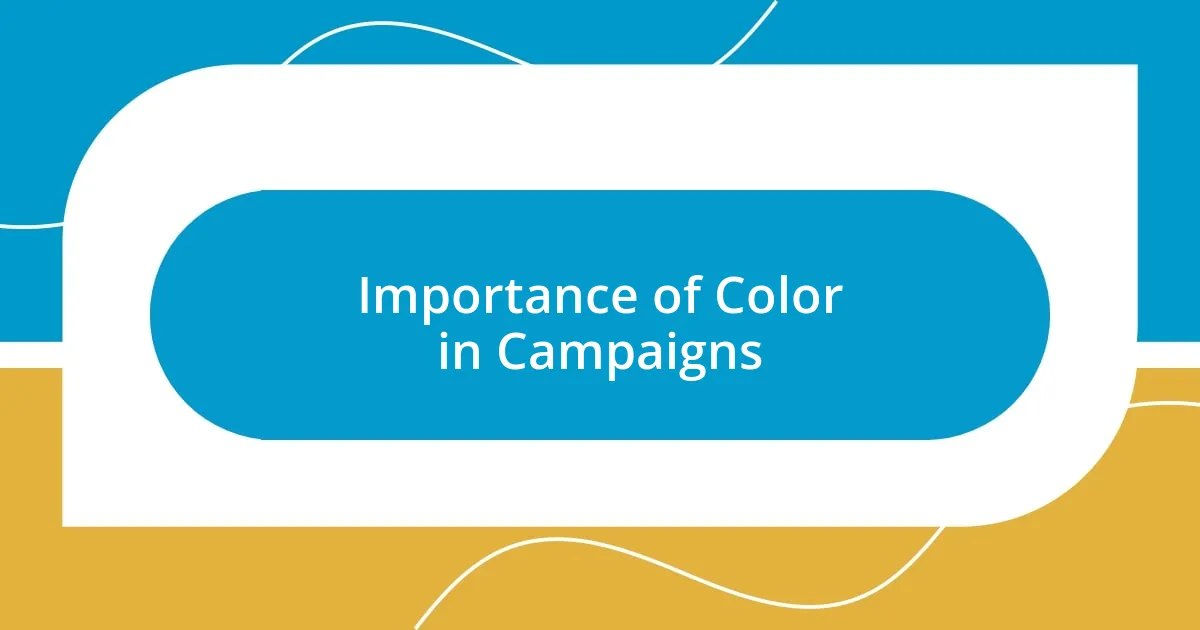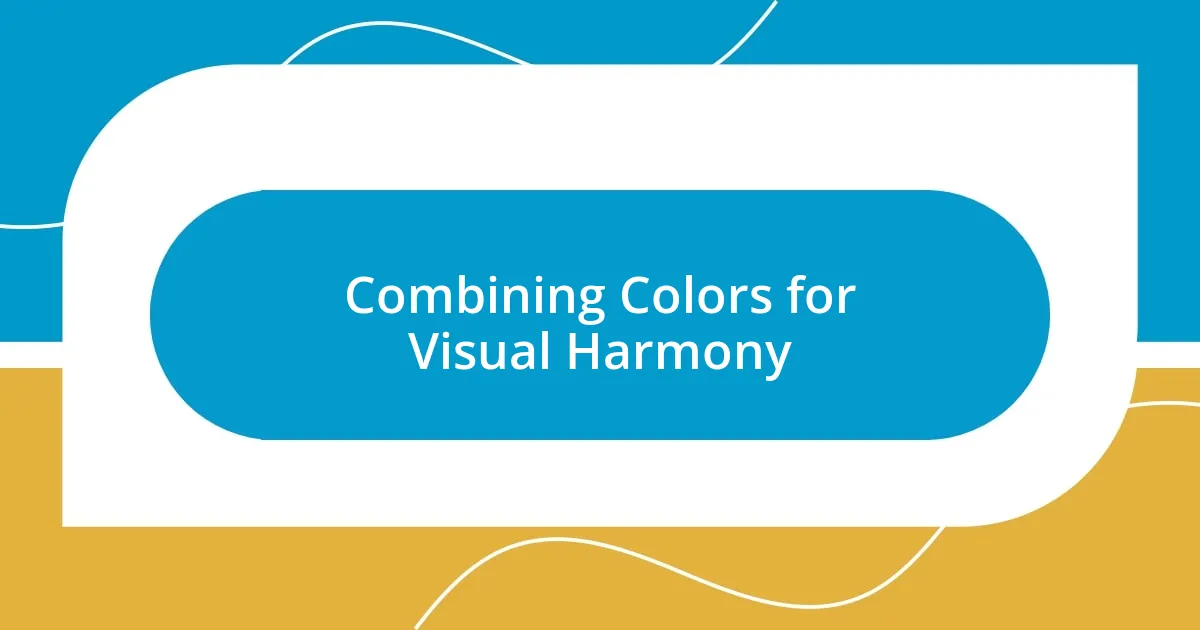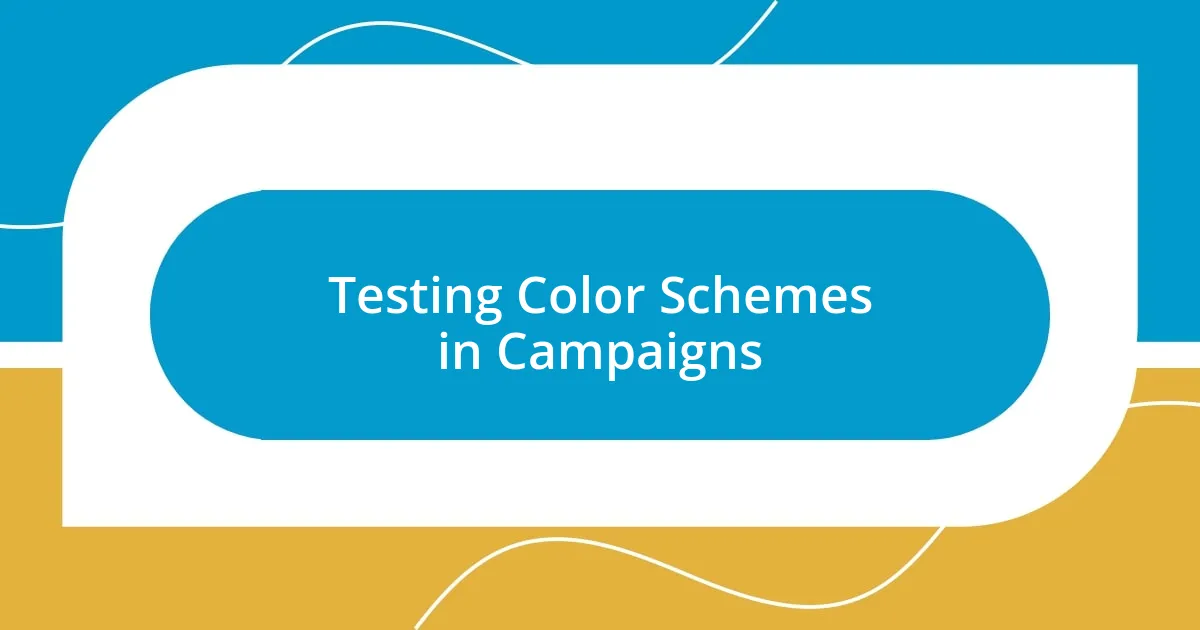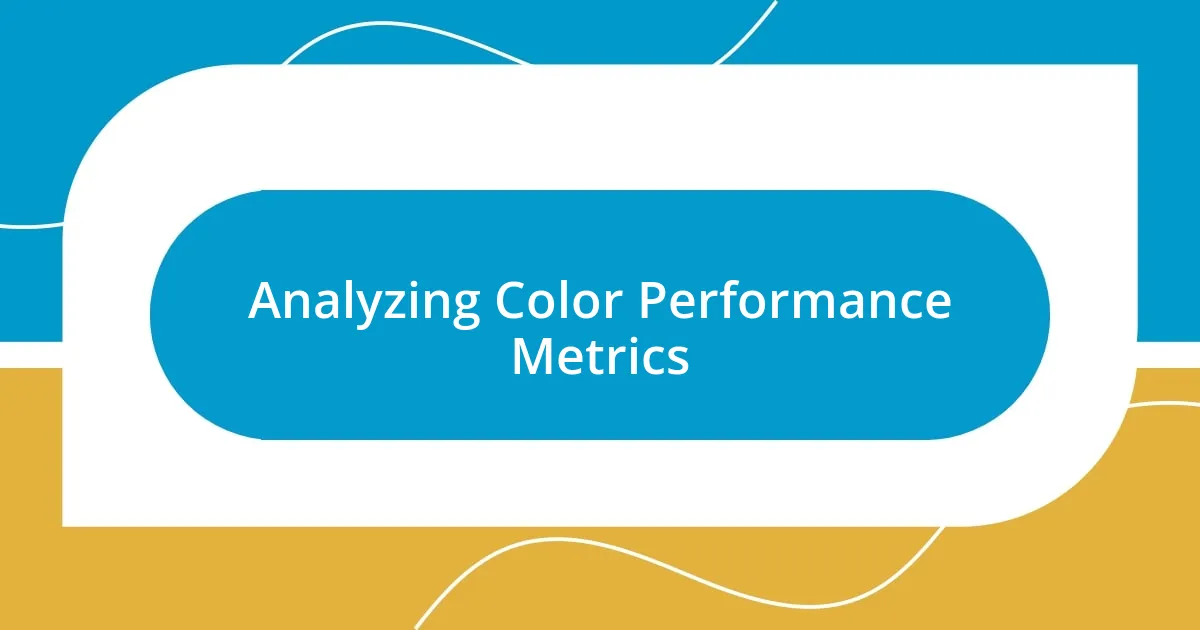Key takeaways:
- Color theory drives design choices, influencing emotions and behaviors, as seen in campaigns using red for urgency and blue for trust.
- Understanding target audience preferences and cultural meanings of colors is crucial for creating emotional connections.
- Testing different color schemes can reveal audience preferences, highlighting the importance of data-driven decisions in campaign effectiveness.
- Analyzing color performance metrics can enhance engagement and conversions, demonstrating that color choices significantly impact consumer perceptions.

Understanding Color Theory Basics
Color theory is the foundation of every design decision I make in my campaigns. It’s a system that explains how colors interact, influence moods, and drive behavior. Have you ever noticed how a bright red can evoke urgency or passion while a soft blue can create a sense of calm? Understanding these emotional responses is crucial.
In my experience, I’ve found that the color wheel—a simple tool illustrating primary, secondary, and tertiary colors—can guide my choices. When I started exploring complementary colors, it opened a whole new world for me. By pairing colors that sit opposite each other on the wheel, I created visuals that really pop. This knowledge helped not only in grabbing attention but also in conveying messages more effectively.
Diving deeper, I learned about warm versus cool colors and their psychological impact. Warm colors like orange and yellow can make people feel more energetic, while cool colors such as greens and blues often evoke tranquility. During a recent campaign, I incorporated warm colors to boost excitement, and the response was overwhelming. It’s fascinating to see how choosing the right palette can shape perceptions and influence the success of a campaign.

Importance of Color in Campaigns
Color plays an integral role in defining a campaign’s identity. I remember a particular project where I opted for a palette dominated by green tones. The response was remarkable. People connected emotionally, associating the color with nature, freshness, and renewal—feelings I intentionally wanted to convey. It’s truly enlightening to witness how a color can amplify a brand’s core message and foster strong connections with the audience.
Moreover, the psychological impact of color is a game changer. For instance, during one ad campaign, I used shades of blue to promote trustworthiness. The results were staggering; not only did engagement increase, but the audience felt more secure in the product I was promoting. It just reaffirms my belief that using the right colors can significantly enhance the effectiveness of a campaign by tapping into the audience’s subconscious emotions.
In my view, color is not just about aesthetics; it’s about storytelling. When I was crafting a recent campaign for a wellness brand, I deliberately chose pastel colors to evoke a sense of calm and well-being. The outcome was a significantly higher conversion rate because the visuals resonated well with the brand’s message. It’s a powerful reminder that color choices can completely transform how a message is perceived and acted upon.
| Color | Associated Emotion |
|---|---|
| Red | Urgency, Passion |
| Blue | Trust, Calm |
| Green | Renewal, Nature |
| Yellow | Energy, Happiness |
| Orange | Excitement, Warmth |

Choosing Colors for Target Audience
Choosing colors for your target audience is a nuanced process that involves understanding their preferences and emotions. I once worked on a campaign aimed at a younger demographic, which led me to incorporate vibrant colors like pink and turquoise. The feedback was incredibly positive; these colors resonated with the audience’s energy and vibrancy, making them feel more connected to the brand. It’s remarkable how the right hues can create an immediate emotional tie with your audience.
When selecting colors, I keep in mind specific demographics and their cultural backgrounds, as colors can have varying meanings across cultures. For instance, while white symbolizes purity in some cultures, it can signify mourning in others. To ensure my choices align with my audience’s perception, I often consider the following factors:
- Age: Younger audiences may prefer bolder colors, while older audiences might lean towards muted tones.
- Gender: Certain colors can resonate differently; for example, pastels might appeal more to women, whereas darker shades might attract men.
- Cultural significance: Researching color meanings in different cultures helps prevent misunderstandings.
- Trends: Staying updated on current color trends is vital, as they can influence how an audience perceives a brand.
- Emotional triggers: Identifying the emotions you want your audience to feel guides your color selection process.
This personalized approach has continuously helped me connect more effectively with my audiences.

Creating Emotional Responses with Colors
Colors truly have the power to elicit strong emotional reactions. I recall a campaign for a charity event where I used a deep red for the promotional materials. That color choice evoked passion and urgency, perfectly aligning with our goal of encouraging immediate donations. The surge in response was telling—it reinforced my belief that the right hue can ignite a genuine emotional spark in the audience.
It’s fascinating how personal experiences shape our perception of color. Have you ever noticed how certain colors transport you back to a specific memory? I chose a soft yellow for a campaign celebrating childhood education, which reminded many of the warmth and happiness of their own school days. The nostalgia resonated deeply, increasing engagement as people shared their cherished moments with us. It’s a remarkable way to create a genuine connection through color.
I’ve also found that utilizing contrasting colors can elevate emotional responses even further. During a fashion campaign, I used bold orange alongside a deep blue to signify excitement and calmness, respectively. The vibrant contrast drew attention while also providing a sense of balance. This duality tapped into different emotions within viewers, demonstrating how strategic color combinations can amplify the overall message. Think about your own experiences—do you have favorite color combinations that evoke particular feelings? Exploring those can unfold new insights into how we connect emotionally through color.

Combining Colors for Visual Harmony
When I think about combining colors for visual harmony, I often reflect on my experience with a local art festival campaign. I chose a palette of soft greens and warm earthy tones. The result was a serene yet inviting atmosphere that encouraged attendees to explore and enjoy the exhibits. It’s incredible how blending such colors can create a unified visual experience that feels both calming and welcoming.
Sometimes I experiment with triadic color schemes, which involve three colors spaced equally on the color wheel. For example, during a wellness retreat campaign, I used a combination of teal, coral, and mustard. This trio provided a vibrant yet balanced look, capturing the energy of the event while maintaining visual harmony. Have you noticed how certain combinations can bring out the best in each other? The interplay of these colors not only grabbed attention but also ensured that the messaging and visuals felt cohesive and intentional.
I often find that the context matters just as much as the colors themselves. In one campaign for a sustainable product line, I paired deep blue with soft beige. This harmonious blend not only conveyed a natural ethos but also echoed a sense of reliability and trust. It made me realize that combining colors isn’t solely about aesthetics; it’s about telling a story. How do you manage to tell stories through the colors you choose? That’s the magic of intentional color combinations.

Testing Color Schemes in Campaigns
Testing color schemes is a crucial step in developing effective campaigns. I once rolled out a series of test ads with varying color schemes for a fitness brand. Some designs used vibrant greens for energy, while others featured muted blues for calmness. Surprisingly, the ads with yellows and oranges performed best, capturing attention and driving engagement. This experience taught me that testing is not just about selecting colors; it’s about discovering what resonates with your audience.
In my early days as a campaign strategist, I ran a focus group to analyze different color palettes. I was particularly intrigued by the responses to a bold pink versus a more subdued nude tone in a beauty campaign. The deep pink stirred excitement, particularly among younger participants, while the nude suggested sophistication to an older crowd. These insights gave me a newfound appreciation for demographic nuances. Isn’t it fascinating how a single hue can sway opinions across age groups?
I often leverage A/B testing, where two color variations are showcased to see which garners a stronger response. For instance, during a recent launch for a tech gadget, I tried both sleek black and vibrant red in the promotional materials. The red not only outperformed in terms of clicks but also stimulated more conversation on social media. It reinforced my belief that color testing isn’t just an aesthetic choice—it’s a data-driven approach to crafting campaigns that truly connect. Have you ever noticed how testing different options can unveil unexpected preferences? It surely has for me.

Analyzing Color Performance Metrics
When analyzing color performance metrics, I like to dig deep into engagement data and audience reactions. For one campaign centered around organic skincare, I discovered that the earthy greens I chose generated significantly higher interaction rates compared to a bright, flashy pink. It prompted me to ask myself—why does a muted hue feel more authentic to a natural product? Understanding these metrics isn’t just about numbers; it’s about capturing the very essence of the audience’s preferences and emotions.
I also recall a particular moment when I linked color performance to conversion rates during a holiday sale for a home décor brand. The metrics showed that a softer palette of pastels led to increased sales during the campaign compared to bold primary colors. This revelation felt like a lightbulb moment for me. Could it be that calm and comforting colors resonate more with customers when they’re in a holiday shopping mindset? Analyzing performance metrics gave me this clarity, allowing me to align color choices with the consumer’s emotional journey.
Incorporating tools like heat maps allowed me to see where visitors’ eyes lingered on my campaign visuals. I remember analyzing a layout for a travel campaign where calming blues directed attention toward the call to action. Seeing the data in visual form sparked my curiosity about how the psychological impacts of color can be so pronounced. Does color truly create a pathway for engagement, or is it our perception shaping this behavior? The metrics provide compelling evidence that color affects our actions in more ways than we often realize.












